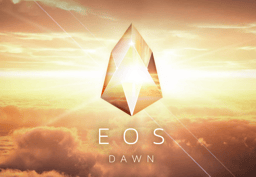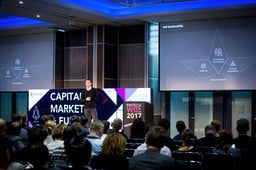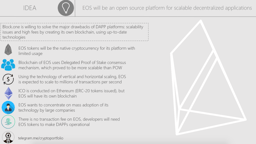EOS

EOS

MDX Crypto: EOS Partners With Google!
EOS (ticker symbol: EOS) is a blockchain built from the ground up by Block.one to be an operating system for decentralized applications (dApps) allowing developers to create, launch, and host decentralized applications and decentralized autonomous corporations (DACs). [8] [14] [13] It adds a number of improvements over existing Blockchain applications, mainly scalability and speed.[42][43]
Overview
The aim of the platform is to provide smart contract and decentralized storage enterprise solutions that solve the scalability issues of blockchains like Bitcoin and Ethereum, as well as eliminating all fees for users. EOS.IO accomplishes this by being both multi-threaded (able to run on multiple computer cores) as well as using delegated proof-of-stake for its consensus protocol. [14] [13]
It aims to be the first decentralized operating system that provides a development environment for decentralized applications like Steemit.
EOS claims to be “the most powerful infrastructure for decentralized applications.”
Basically, EOS is (or, rather, will be) a blockchain technology much like Ethereum.
They plan to create their own blockchain with a long list of impressive features.
Some are even calling EOS the “Ethereum killer.”
But along with all the hype and excitement about EOS, there’s also a large amount of skepticism coming from the crypto community.
EOS applies the Graphene (blockchain technology), which is a blockchain framework technology based on DPoS. With Graphene, a blockchain can deal with up to ten thousand transactions per second (TPS).[46]
The EOSIO platform provides functionalities such as accounts, authentication, databases, asynchronous communication, and the scheduling of applications across multiple CPU cores and clusters.[51]
EOS Token
The native token, EOS, is a utility token that provides both bandwidth and storage on the blockchain, in proportion to one's total staked tokens (owning 1% of EOS tokens allows for usage of up to 1% of the total available bandwidth). EOS tokens also allow the owner to cast votes and participate in the on-chain governance of the blockchain, again in proportion to the owner's staked tokens. [14] [13]
In order to ensure widespread distribution of the native token at the launch of the blockchain, one billion tokens were sold over a period of one year on the Ethereum blockchain by Block.one. This provides a distribution that anyone can use to launch the EOS blockchain once the software is released, while the CEO of Block.one, Brendan Blumer, announced that Block.one will support the EOS.IO blockchain with over 4 billion USD in funding from the token sale. [14] [13]
History
Based on a white paper that was published in 2017, the EOS.IO platform was developed by a private company, Block.one, and was released as open-source software on June 1st, 2018. The official white paper for the EOS.IO platform was first published in 2017. At the time, the platform was being developed by Block.One and was officially released on June 1, 2018. The network uses EOS as its cryptocurrency and it has gone on to become one of the most prominent in the industry. The original testnet Dawn 1.0 was officially released in September 2017 and full versions were released both in 2017 and 2018.[47]
On June 2, 2018, the pre-sale ICO ended and the ERC-20 tokens were frozen for the mainnet launch.
On June 9th, 2018 the initial group of block producers voted "yes" to officially launch the mainnet block producer voting system.
On June 14th, 2018 15% (15,000,000 EOS) of EOS tokens were staked and used to vote.
By reaching 15%, the network enabled all functionalities and was considered the official chain.
Google Cloud
In October 2020, Google Cloud joined the EOS blockchain network as a block producer candidate. On October 6, Block.one said that Google Cloud is "taking steps" toward becoming an EOS network block producer (BP), organizations that are able to bid for EOS governance votes alongside standby block producers (SBP). If accepted as a block producer, Google will have a say in the future security, scalability, and decentralization aspects of the blockchain. However, Google Cloud must first be selected by existing token holders on the EOS network. The criteria to be accepted is in a constant state of evolution. [54]
Allen Day, Developer Advocate, Google Cloud explained how and why Google Cloud is joining EOS as a block producer candidate:
“We’re starting the process of becoming a block producer candidate.
As organizations begin to incorporate distributed ledger technology into their infrastructures, we are committed to ensuring that the information on public blockchains are securely stored, reliably available, and can be accessed in meaningful ways.”
Allen Day has said that Google Cloud is becoming a block producer candidate because they see value in EOS's infrastructure, the focus is not on earning block producer rewards.
“Google Cloud is not getting into crypto mining.
This is really an infrastructure play for us.”
Block.one CTO Dan Larimer explained how Google Cloud becoming a block producer would benefit blockchain technology as a whole:
"Google Cloud will continue to provide its highly provisioned, low-latency infrastructure to Block.one.
“Through secure oracles, inter-chain transaction reporting, key management, and high-integrity full-node validation, Google Cloud’s confidential computing infrastructure will enhance the security, scalability, and decentralization of blockchain technology.”
Block.one CEO Brendan Blumer welcomed Google Cloud to EOS explaining the value of the partnership:
“With the majority of global public blockchain activity, EOS is a powerful solution for anyone looking to leverage the decentralized ecosystem with ease,” said Brendan Blumer, CEO of Block.one.
“The Google Cloud team understands the thriving EOS community and the highly performant EOSIO technology on which it builds create the best entry point into the blockchain industry.
We welcome Google Cloud to the EOS community and are excited for their contributions to the EOS network.”
Features of EOS.IO
The EOS.IO software platform utilizes a Dpos (Delegated-Proof-Of-Stake) algorithm, which according to Block.one provides a much faster transaction approval process via blockchain than competing technologies such as bitcoin. The company promises that the platform will have zero transaction fees and the capacity to process millions of transactions per second, which would give it a major advantage over Ethereum.
The EOS development team has also announced plans to establish what is known as fair block production voting, on the premise that holders and investors can be assured they are acquiring more than just units of a digital asset when buying EOS.
Owners also become eligible for voting, entering the system of block production by virtue of having a certain amount of EOS units.
The system allowing them to vote also bases it proportionately on the number of tokens in their digital wallet.
Fair block production voting also means the team has taken steps to ensure that major exchange markets such as Bitfinex and Huobi don’t gain a monopoly over the EOS network.
This aim was accomplished earlier this month via what was termed an ‘Evolution Airdrop’.
Working slightly differently from an ICO, the airdrop – the first was on May 10th, with another to follow – represents the means of enabling tokens “to get evenly and equitably distributed across the network, that way honoring fairness, decentralization and the crypto community”.
EOSIO For Business
On October 15, 2020, Block One introduced EOSIO for businesses, a suite of enterprise service offerings designed to help organizations integrate blockchain-based solutions into their operations.
This service comes with various features, including blockchain hosting, technical support, training and certifications for developers, and customized development solutions.
Ted Cahall the COO at Block.one explained how EOSIO for Business will help clients implement blockchain solutions
“Our EOSIO for Business customers will be able to work directly with EOSIO experts to ensure that their implementations seamlessly integrate with their existing technology.
Business clients will also have access to the newest EOSIO features and upgrades – all of which are designed to enable their development teams to remain focused on their own business priorities while leveraging Block.one’s specialized experience in delivering world-class blockchain innovation.”
The service's main products include:
EOSIO Premier Technical Support allows for companies to easily allocate the necessary troubleshooting and technical assistance 'in order to launch and maintain operations for an EOSIO implementation.'
EOSIO BaaS is an automated blockchain platform that is fully handled by Block.one. This service allows companies to use blockchain technology without having to use their available resources for continuous maintenance.
EOSIO Consulting offers companies direct access to consulting from EOSIO engineers, who would be able to plan, develop, and implement blockchain solutions, including EOSIO smart contracts.
EOSIO Training and Certification includes courses that cover the fundamentals of EOSIO, smart contract programming, app development, and security practices for the service.[57]
Mythical Games, the game technology studio on the Forbes “Disruptive Technology Companies to watch” list, is an EOSIO for Business customers. They used EOSIO for Business services to create digital ecosystems around player-owned economies. [57]
Rudy Koch, Co-founder and SVP of Business Development at Mythical Games, explained how EOSIO for Business has helped their company:
“At Mythical, we are redefining game economies and creating new revenue opportunities by putting more power and ownership in the hands of players and content creators.
EOSIO is an integral part of our efforts.
Leveraging Block.one’s EOSIO BaaS service enables us to continue delivering world-class game technology products to our players and partners.”
EOSIO Core
Keosd
Keosd is a key management service daemon for storing private keys and signing digital messages.
It provides a secure key storage medium for keys to be encrypted at rest in the associated wallet file.
Keosd also defines a secure enclave for signing transactions created by Cleos or a third party library.[50]
Nodeos
Nodeos is a core EOSIO node daemon that, using plugins, is configured to run a node in the EOSIO network.
As a building block of the EOSIO network, Nodeos provides the foundation for blockchain functionality.
This repository contains the basic essentials a user will need to know to set up and run an EOSIO based blockchain.
Nodes can be connected to an existing blockchain network and synchronize existing history or used to create a new blockchain with custom parameters.[50]
Cleos
Developers need the means to interact with blockchain networks and EOSIO cane with a default command-line interface called Cleos.
Cleos is designed to make a developer’s life easier by providing the basic tools for interaction with EOSIO blockchains, both for reading data from the blockchain history and for sending new transactions to the blockchain.[50]
Reference Smart Contracts
To standardize and speed up the development process on EOSIO, the Reference Smart Contracts repository contains a list of basic smart contracts commonly needed for EOSIO applications.
These contracts serve as a template for best practices and safe and secure development on EOSIO.
Examples include eosio.system, eosio.token, the Resource Exchange (REX), and more.[50]
EOSIO 2
Block.one, the company behind EOSIO, unveiled EOSIO 2 on October 7, 2019, saying the newest iteration of the platform was built with developers in mind. According to the company’s official blog post, the focus of EOSIO 2 was to create a faster, simpler, and more secure way to build on EOSIO. Block.one set out to solve problems they believe all developers face when building on blockchains: the speed in which smart contracts are executed, the complexity of onboarding new developers, and the security of private and public keys.
The four major components included in the EOSIO 2.0 Release Candidate:
EOS VM: A high-performance WebAssembly (WASM) engine specialized for blockchain applications that facilitates more efficient use of system resources when processing smart contracts and substantial performance gains.
EOSIO Quickstart Web IDE: A powerful, new, self-contained, web-based integrated development environment for building EOSIO smart contracts and associated web applications. It can be set up in minutes, run in any browser, and helps lower the barrier to entry for new EOSIO blockchain developers.
WebAuthn Support: A widely accepted secure authentication standard that enables transaction signing without browser extensions or additional software.
Weighted Threshold Multi-Signature Block Production Support: A secure way for block producers to use different keys to sign blocks on primary and backup block production hardware.[49]
EOSIO Blockchain Networks
EOS: The first global public EOSIO blockchain network started by a community of block producers and thousands of enterprising individuals in 2018 upon the release of the EOSIO blockchain software.
The EOS network is one of the most developed EOSIO networks and is one of the most widely adopted, performant, and decentralized public blockchain networks leveraging the DPoS (Delegated-Proof-Of-Stake) consensus mechanism.
BOSCore: The BOS Network is committed to providing users with easy-to-access and easy-to-use blockchain services, providing a more user-friendly infrastructure for DApp operations, working to support richer application scenarios, and actively promoting prosperity in trustless commerce.
COFFE network: COFFE is an EOSIO platform fork (an independent software development branch) that features modified DPoS-based consensus algorithms.
EOSfinex: eosfinex is a scalable and transparent platform for digital asset trading, industry-leading security, and instant execution.
EOSForce: A decentralized high-performance smart contract platform.
Europechain: Europechain is a GDPR-supported enterprise blockchain platform managed and governed by experienced validators registered in the European Union.
Meet.one: Based on the concept of open and sharing, the MEET.ONE team will build a blockchain infrastructure based on EOSIO, work with block producers and developers to promote the development of trusted Internet and work together to empower the internet with blockchain.
Proton: Proton is a new public blockchain and smart contract platform designed for both consumer applications and peer-peer payments.
RemChain: The first public blockchain built on top of Remme's Public Key Infrastructure Protocol.
Telos: Telos is a smart contract blockchain built to support the economies of the future.
Ultra: Ultra is bringing the blockchain revolution to the gaming industry and creating a fair ecosystem for the future of games distribution.
Wax: Wax has created a full suite of blockchain-based tools that allows anyone to trade digital or even physical items instantly and securely, to anyone, anywhere.
WORBLI: WORBLI is a financial services-oriented blockchain network.[52]
List of ICOs and dApps
The following is a list of a few decentralized applications running on EOS technology.
See Also
List Of All Cryptocurrencies










